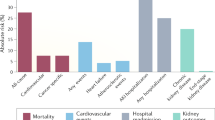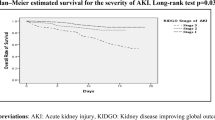Abstract
Acute kidney injury (AKI) is common and increasing in hospitalized patients. The earlier recognition of renal injury, at a stage described as 'incipient AKI', may allow renoprotective strategies to be initiated at a time when more kidney tissue is salvageable. 'Incipient AKI' represents renal injury as manifested by new-onset proteinuria, cellular activity on urine microscopy, or elevated novel biomarkers of kidney injury in the absence of clinical data that meet current diagnostic criteria for AKI. We propose three strategies to preserve kidney function and minimize further kidney injury in patients with 'incipient AKI'. These include—when appropriate for the prevailing cause of 'incipient AKI'—use of low-chloride-containing intravenous solutions, continued use of renin–angiotensin system antagonists, and use of diuretics to achieve adequate control of intravascular volume. The combined approach of the early diagnosis of AKI and early employment of feasible therapeutic strategies may slow the growth of clinical AKI, AKI requiring renal replacement therapy and chronic kidney disease, and might reduce AKI-associated mortality.
This is a preview of subscription content, access via your institution
Access options
Subscribe to this journal
Receive 12 print issues and online access
$209.00 per year
only $17.42 per issue
Buy this article
- Purchase on Springer Link
- Instant access to full article PDF
Prices may be subject to local taxes which are calculated during checkout



Similar content being viewed by others
References
Bellomo, R. et al. Acute renal failure—definition, outcome measures, animal models, fluid therapy and information technology needs: the second international Consensus Conference of the Acute Dialysis Quality Initiative (ADQI) Group. Crit. Care 8, R205–R212 (2004).
Mehta, R. L. et al. Acute Kidney Injury Network: report of an initiative to improve outcomes in acute kidney injury. Crit. Care 11, R31 (2007).
Hsu, R. K., McCulloch, C. E., Dudley, R. A., Lo, L. J. & Hsu, C. Y. Temporal changes in incidence of dialysis-requiring AKI. J. Am. Soc. Nephrol. 24, 37–42 (2013).
Siddiqui, N. F. et al. Secular trends in acute dialysis after elective major surgery—1995 to 2009. CMAJ 184, 1237–1245 (2012).
Faubel, S. et al. Ongoing clinical trials in AKI. Clin. J. Am. Soc. Nephrol. 7, 861–873 (2012).
Ricci, Z. et al. Practice patterns in the management of acute renal failure in the critically ill patient: an international survey. Nephrol. Dial. Transplant. 21, 690–696 (2006).
Kidney Disease: Improving Global Outcomes. KDIGO clinical practice guideline for acute kidney injury. Kidney Int. Suppl. 2, 19–36 (2012).
Ishani, A. et al. The magnitude of acute serum creatinine increase after cardiac surgery and the risk of chronic kidney disease, progression of kidney disease, and death. Arch. Intern. Med. 171, 226–233 (2011).
Haase, M. et al. The outcome of neutrophil gelatinase-associated lipocalin-positive subclinical acute kidney injury: a multicenter pooled analysis of prospective studies. J. Am. Coll. Cardiol. 57, 1752–1761 (2011).
Nickolas, T. L. et al. Diagnostic and prognostic stratification in the emergency department using urinary biomarkers of nephron damage: a multicenter prospective cohort study. J. Am. Coll. Cardiol. 59, 246–255 (2012).
Devarajan, P. et al. Proteomic identification of early biomarkers of acute kidney injury after cardiac surgery in children. Am. J. Kidney Dis. 56, 632–642 (2010).
Tallgren, M. et al. Acute renal injury and dysfunction following elective abdominal aortic surgery. Eur. J. Vasc. Endovasc. Surg. 33, 550–555 (2007).
Dittrich, S. et al. Renal function after cardiopulmonary bypass surgery in cyanotic congenital heart disease. Int. J. Cardiol. 73, 173–179 (2000).
Zappitelli, M. et al. The association of albumin/creatinine ratio with postoperative AKI in children undergoing cardiac surgery. Clin. J. Am. Soc. Nephrol. 7, 1761–1769 (2012).
Molnar, A. O. et al. Association of postoperative proteinuria with AKI after cardiac surgery among patients at high risk. Clin. J. Am. Soc. Nephrol. 7, 1749–1760 (2012).
Hu, J. Y. et al. Relation between proteinuria and acute kidney injury in patients with severe burns. Crit. Care 16, R172 (2012).
Schentag, J. J. et al. Urinary casts as an indicator of renal tubular damage in patients receiving aminoglycosides. Antimicrob. Agents Chemother. 16, 468–474 (1979).
Chawla, L. S., Dommu, A., Berger, A., Shih, S. & Patel, S. S. Urinary sediment cast scoring index for acute kidney injury: a pilot study. Nephron Clin. Pract. 110, c145–c150 (2008).
Perazella, M. A. et al. Urine microscopy is associated with severity and worsening of acute kidney injury in hospitalized patients. Clin. J. Am. Soc. Nephrol. 5, 402–408 (2010).
Bagshaw, S. M. et al. A prospective evaluation of urine microscopy in septic and non-septic acute kidney injury. Nephrol. Dial. Transplant. (2011).
Hall, I. E. et al. Risk of poor outcomes with novel and traditional biomarkers at clinical AKI diagnosis. Clin. J. Am. Soc. Nephrol. 6, 2740–2749 (2011).
Schinstock, C. A. et al. Urinalysis is more specific and urinary neutrophil gelatinase-associated lipocalin is more sensitive for early detection of acute kidney injury. Nephrol. Dial. Transplant. http://dx.doi.org/10.1093/ndt/gfs127.
Bullivant, E. M., Wilcox, C. S. & Welch, W. J. Intrarenal vasoconstriction during hyperchloremia: role of thromboxane. Am. J. Physiol. 256, F152–F157 (1989).
Yunos, N. M. et al. The biochemical effects of restricting chloride-rich fluids in intensive care. Crit. Care Med. 39, 2419–2424 (2011).
Shaw, A. D. & Kellum, J. A. The risk of AKI in patients treated with intravenous solutions containing hydroxyethyl starch. Clin. J. Am. Soc. Nephrol. 8, 497–503 (2013).
Shaw, A. D. et al. Major complications, mortality, and resource utilization after open abdominal surgery: 0.9% saline compared to Plasma-Lyte. Ann. Surg. 255, 821–829 (2012).
Yunos, N. M. et al. Association between a chloride-liberal vs chloride-restrictive intravenous fluid administration strategy and kidney injury in critically ill adults. JAMA 308, 1566–1572 (2012).
Nobes, M. S., Harris, P. J., Yamada, H. & Mendelsohn, F. A. Effects of angiotensin on renal cortical and papillary blood flows measured by laser-Doppler flowmetry. Am. J. Physiol. 261, F998–F1006 (1991).
Norman, J. T., Stidwill, R., Singer, M. & Fine, L. G. Angiotensin II blockade augments renal cortical microvascular pO2 indicating a novel, potentially renoprotective action. Nephron Physiol. 94, 39–46 (2003).
Omoro, S. A., Majid, D. S., El Dahr, S. S. & Navar, L. G. Roles of ANG II and bradykinin in the renal regional blood flow responses to ACE inhibition in sodium-depleted dogs. Am. J. Physiol. Renal Physiol. 279, F289–F293 (2000).
Tawfik, M. K. Renoprotective activity of telmisartan versus pioglitazone on ischemia/reperfusion induced renal damage in diabetic rats. Eur. Rev. Med. Pharmacol. Sci. 16, 600–609 (2012).
Molinas, S. M. et al. Effects of losartan pretreatment in an experimental model of ischemic acute kidney injury. Nephron Exp. Nephrol. 112, e10–e19 (2009).
Mejia-Vilet, J. M. et al. Renal ischemia-reperfusion injury is prevented by the mineralocorticoid receptor blocker spironolactone. Am. J. Physiol. Renal Physiol. 293, F78–F86 (2007).
Krishan, P., Sharma, A. & Singh, M. Effect of angiotensin converting enzyme inhibitors on ischaemia-reperfusion-induced renal injury in rats. Pharmacol. Res. 37, 23–29 (1998).
Balasubramanian, G. et al. Early nephrologist involvement in hospital-acquired acute kidney injury: a pilot study. Am. J. Kidney Dis. 57, 228–234 (2011).
Testani, J. M., Kimmel, S. E., Dries, D. L. & Coca, S. G. Prognostic importance of early worsening renal function after initiation of angiotensin-converting enzyme inhibitor therapy in patients with cardiac dysfunction. Circ. Heart Fail. 4, 685–691 (2011).
Holtkamp, F. A. et al. An acute fall in estimated glomerular filtration rate during treatment with losartan predicts a slower decrease in long-term renal function. Kidney Int. 80, 282–287 (2011).
Haase, M., Kellum, J. A. & Ronco, C. Subclinical AKI—an emerging syndrome with important consequences. Nat. Rev. Nephrol. 8, 735–739 (2012).
Sward, K., Valsson, F., Sellgren, J. & Ricksten, S. E. Differential effects of human atrial natriuretic peptide and furosemide on glomerular filtration rate and renal oxygen consumption in humans. Intensive Care Med. 31, 79–85 (2005).
Dupont, M. et al. Lack of significant renal tubular injury despite acute kidney injury in acute decompensated heart failure. Eur. J. Heart Fail. 14, 597–604 (2012).
Damman, K. et al. Volume status and diuretic therapy in systolic heart failure and the detection of early abnormalities in renal and tubular function. J. Am. Coll. Cardiol. 57, 2233–2241 (2011).
Felker, G. M. et al. Diuretic strategies in patients with acute decompensated heart failure. N. Engl. J. Med. 364, 797–805 (2011).
Grams, M. E. et al. Fluid balance, diuretic use, and mortality in acute kidney injury. Clin. J. Am. Soc. Nephrol. 6, 966–973 (2011).
Testani, J. M., Chen, J., McCauley, B. D., Kimmel, S. E. & Shannon, R. P. Potential effects of aggressive decongestion during the treatment of decompensated heart failure on renal function and survival. Circulation 122, 265–272 (2010).
Testani, J. M., Coca, S. G., McCauley, B. D., Shannon, R. P. & Kimmel, S. E. Impact of changes in blood pressure during the treatment of acute decompensated heart failure on renal and clinical outcomes. Eur. J. Heart Fail. 13, 877–884 (2011).
Bart, B. A. et al. Ultrafiltration in decompensated heart failure with cardiorenal syndrome. N. Engl. J. Med. 367, 2296–2304 (2012).
Testani, J. M., Cappola, T. P., Brensinger, C. M., Shannon, R. P. & Kimmel, S. E. Interaction between loop diuretic-associated mortality and blood urea nitrogen concentration in chronic heart failure. J. Am. Coll. Cardiol. 58, 375–382 (2011).
Peacock, W. F. et al. Impact of intravenous loop diuretics on outcomes of patients hospitalized with acute decompensated heart failure: insights from the ADHERE registry. Cardiology 113, 12–19 (2009).
Yilmaz, M. B. et al. Impact of diuretic dosing on mortality in acute heart failure using a propensity-matched analysis. Eur. J. Heart Fail. 13, 1244–1252 (2011).
Uchino, S. et al. Diuretics and mortality in acute renal failure. Crit. Care Med. 32, 1669–1677 (2004).
Mehta, R. L., Pascual, M. T., Soroko, S. & Chertow, G. M. Diuretics, mortality, and nonrecovery of renal function in acute renal failure. JAMA 288, 2547–2553 (2002).
Cantarovich, F., Rangoonwala, B., Lorenz, H., Verho, M. & Esnault, V. L. High-dose furosemide for established ARF: a prospective, randomized, double-blind, placebo-controlled, multicenter trial. Am. J. Kidney Dis. 44, 402–409 (2004).
Shah, R. V. et al. Effect of admission oral diuretic dose on response to continuous versus bolus intravenous diuretics in acute heart failure: an analysis from diuretic optimization strategies in acute heart failure. Am. Heart J. 164, 862–868 (2012).
Acknowledgements
S. G. Coca is supported by National Institutes of Health Grants K23DK080132 and R01DK096549. S. G. Coca is also a member of the NIH-sponsored ASsess, Serial Evaluation, and Subsequent Sequelae in Acute Kidney Injury (ASSESS-AKI) Consortium (U01DK082185).
Author information
Authors and Affiliations
Contributions
The authors contributed equally to all aspects of this manuscript.
Corresponding author
Ethics declarations
Competing interests
The authors declare no competing financial interests.
Rights and permissions
About this article
Cite this article
Perazella, M., Coca, S. Three feasible strategies to minimize kidney injury in 'incipient AKI'. Nat Rev Nephrol 9, 484–490 (2013). https://doi.org/10.1038/nrneph.2013.80
Published:
Issue Date:
DOI: https://doi.org/10.1038/nrneph.2013.80
This article is cited by
-
Wirkmechanismen und klinische Anwendung von Diuretika in der Intensivmedizin
Die Anaesthesiologie (2023)
-
Clinical and experimental approaches for imaging of acute kidney injury
Clinical and Experimental Nephrology (2021)
-
A WiFi scanner in conjunction with disposable multiplex paper assay for the quantitation of disease markers in blood plasma
Analytical and Bioanalytical Chemistry (2021)
-
Molecular optical imaging probes for early diagnosis of drug-induced acute kidney injury
Nature Materials (2019)
-
Bcl3: a regulator of NF-κB inducible by TWEAK in acute kidney injury with anti-inflammatory and antiapoptotic properties in tubular cells
Experimental & Molecular Medicine (2017)



